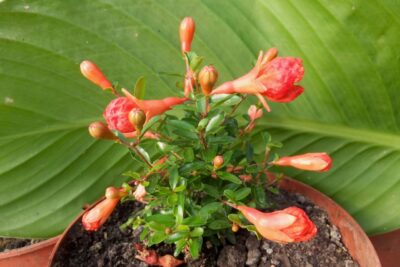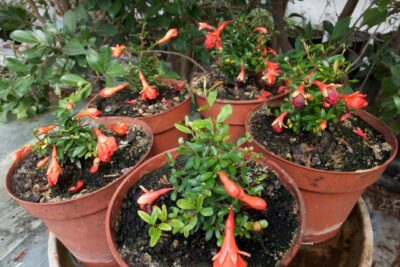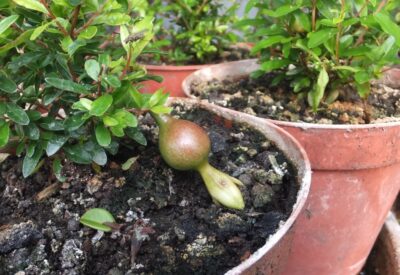
Give your greenhouse an amazing splash of colour through late summer and autumn from sowing the dwarf Pomegranate right now. This natural bonsai is a perfect miniature of the exotic Pomegranate tree only attaining a few inches of height in a year, possibly a metre or more in a decade. Yet despite the tiny growth rate this tree bursts into bloom only months from sowing, and what blooms. Curving scarlet, day-glow trumpets one after the other, day after day, some setting to become miniature fruits (sadly too small and seedy to be other than a taste).

The Pomegranate is a large, tender, bush or tree, first named Mala punica the Carthaginian Apple thought by the Romans from Punicus / Carthage. However puniceus means scarlet so more likely it will have been named from that distinctive hue of the flowers. The Ancient author Pliny recorded nine different varieties. It probably originated between Iran and the Himalyas, according to the Victorian expert Paxton the white form was from China. Oddly the dwarf form recommended here, Punica granatum nana, was thought from the West Indies.
Amazingly as quick into bloom as most annuals the seed’s easy to germinate in a gritty free draining compost, preferably in a warm propagator. Transfer seedlings to small pots, earthenware suits best and looks better anyway. Once you’ve established plants propagate any particularly fine specimens from cuttings, though these are necessarily small and need careful handling. Either way young plants want full sun and warmth, plenty of water and light feeding, and are relatively trouble free.

They don’t like water-logging and although stand drying out are most floriferous when kept growing unchecked. Dead flowers should be collected as they fall otherwise encouraging mould in autumn as humidity increases. Fruits set and really ought to be removed to encourage more flowers, anyway as noted these are tiny, seedy and not awfully juicy though perfectly edible (the juice that is, not the seeds, skin nor pith). The neat leaves are evergreen though may drop if cold or unhappy so need to be frost free and relatively dry through winter, and if getting straggly can be pruned just before growth resumes in spring.


